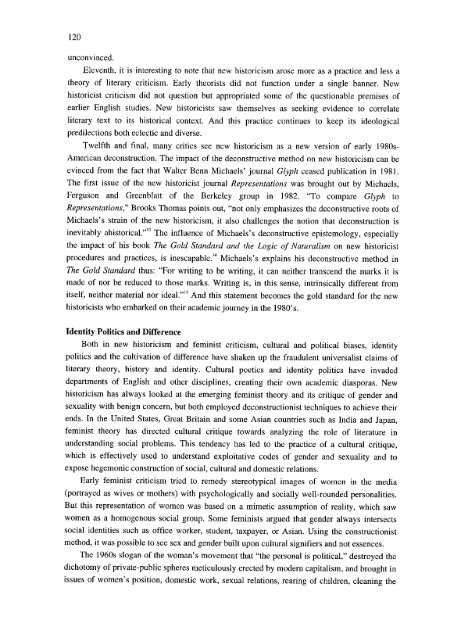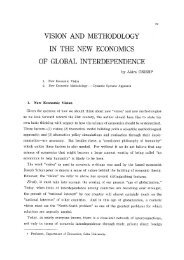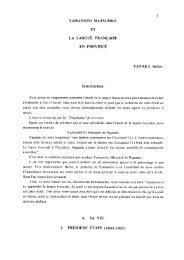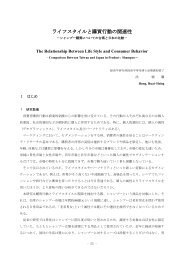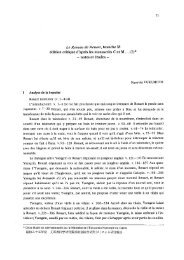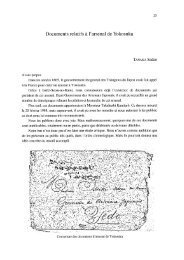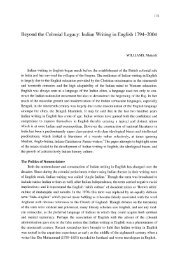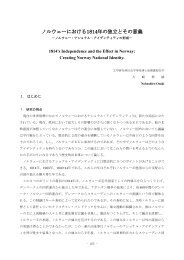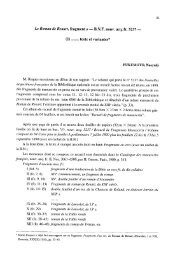New Historicism and Literary Studies - Soka University Repository
New Historicism and Literary Studies - Soka University Repository
New Historicism and Literary Studies - Soka University Repository
Create successful ePaper yourself
Turn your PDF publications into a flip-book with our unique Google optimized e-Paper software.
120<br />
unconvinced.<br />
Eleventh, it is interesting to note that new historicism arose more as a practice <strong>and</strong> less a<br />
theory of literary criticism. Early theorists did not function under a single banner. <strong>New</strong><br />
historicist criticism did not question but appropriated some of the questionable premises of<br />
earlier English studies. <strong>New</strong> historicists saw themselves as seeking evidence to correlate<br />
literary text to its historical context. And this practice continues to keep its ideological<br />
predilections both eclectic <strong>and</strong> diverse.<br />
Twelfth <strong>and</strong> final, many critics see new historicism as a new version of early 1980s-<br />
American deconstruction. The impact of the deconstructive method on new historicism can be<br />
evinced from the fact that Walter Benn Michaels' journal Glyph ceased publication in 1981.<br />
The first issue of the new historicist journal Representations was brought out by Michaels ,<br />
Ferguson <strong>and</strong> Greenblatt of the Berkeley group in 1982. "To compare Glyph to<br />
Representations," Brooks Thomas points out, "not only emphasizes the deconstructive roots of<br />
Michaels's strain of the new historicism, it also challenges the notion that deconstruction is<br />
inevitably ahistorical."13 The influence of Michaels's deconstructive epistemology, especially<br />
the impact of his book The Gold St<strong>and</strong>ard <strong>and</strong> the Logic of Naturalism on new historicist<br />
procedures <strong>and</strong> practices, is inescapable.'4 Michaels's explains his deconstructive method in<br />
The Gold St<strong>and</strong>ard thus: "For writing to be writing, it can neither transcend the marks it is<br />
made of nor be reduced to those marks. Writing is, in this sense, intrinsically different from<br />
itself, neither material nor ideal."15 And this statement becomes the gold st<strong>and</strong>ard for the new<br />
historicists who embarked on their academic journey in the 1980's.<br />
Identity Politics <strong>and</strong> Difference<br />
Both in new historicism <strong>and</strong> feminist criticism, cultural <strong>and</strong> political biases, identity<br />
politics <strong>and</strong> the cultivation of difference have shaken up the fraudulent universalist claims of<br />
literary theory, history <strong>and</strong> identity. Cultural poetics <strong>and</strong> identity politics have invaded<br />
departments of English <strong>and</strong> other disciplines, creating their own academic diasporas . <strong>New</strong><br />
historicism has always looked at the emerging feminist theory <strong>and</strong> its critique of gender <strong>and</strong><br />
sexuality with benign concern, but both employed deconstructionist techniques to achieve their<br />
ends. In the United States, Great Britain <strong>and</strong> some Asian countries such as India <strong>and</strong> Japan ,<br />
feminist theory has directed cultural critique towards analyzing the role of literature in<br />
underst<strong>and</strong>ing social problems. This tendency has led to the practice of a cultural critique ,<br />
which is effectively used to underst<strong>and</strong> exploitative codes of gender <strong>and</strong> sexuality <strong>and</strong> to<br />
expose hegemonic construction of social, cultural <strong>and</strong> domestic relations.<br />
Early feminist criticism tried to remedy stereotypical images of women in the media<br />
(portrayed as wives or mothers) with psychologically <strong>and</strong> socially well-rounded personalities.<br />
But this representation of women was based on a mimetic assumption of reality , which saw<br />
women as a homogenous social group. Some feminists argued that gender always intersects<br />
social identities such as office worker, student, taxpayer, or Asian. Using the constructionist<br />
method, it was possible to see sex <strong>and</strong> gender built upon cultural signifiers <strong>and</strong> not essences .<br />
The 1960s slogan of the woman's movement that "the personal is political," destroyed the<br />
dichotomy of private-public spheres meticulously erected by modern capitalism , <strong>and</strong> brought in<br />
issues of women's position, domestic work, sexual relations , rearing of children, cleaning the


